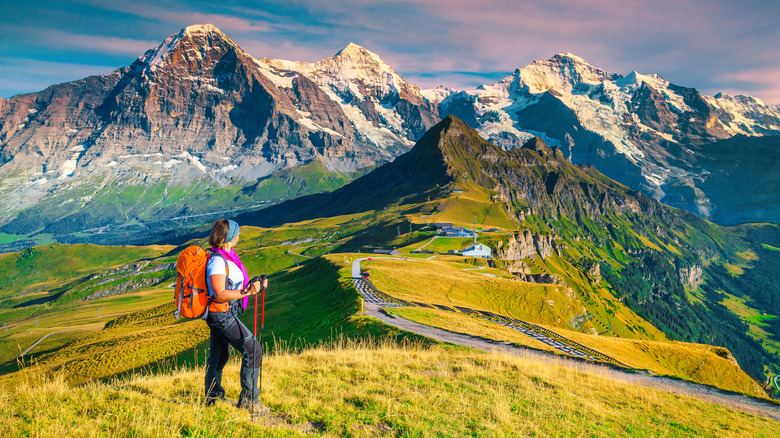Rick Steves Says This Is The Time Of Year To See The Swiss Alps Without Snow On The Trails
Switzerland is often associated with snow-capped mountains and ski slopes, but this wintry landscape undergoes a dramatic transformation once summer rolls in. As travel expert Rick Steves shares on his website, the months of July and August are the best time of the year to hike the idyllic Alpine trails without snow, when the powdery dustings give way to lush green pastures and seasonal blooms. Cleared of any snowfall, the trails become fully accessible, making trail hiking much easier than in the winter. Come summer, Switzerland's temperatures hover between 65 and 82 degrees Fahrenheit. Though summers can get hot enough to work up a sweat, the weather is guaranteed to be cooler the higher up you hike. Steves advises that carrying warm layers of clothing is indispensable no matter the season.
Also, the peak summer months bring about 15 hours of sun. These extended daylight hours, coupled with ideal hiking temperatures, allow hikers to cover more ground than in any other season. After all, there are over 40,000 miles of clearly marked trails and routes in Switzerland to explore. Without snow covering the hiking paths, you'll find it much easier to enjoy the sun-drenched Alpine scenery as you make your way toward Switzerland's prettiest and most iconic destinations that shouldn't be skipped.
Hiking is not the only way to marvel at the Swiss Alps. Steves notes that July and August in Switzerland offer the "busiest schedule of tourist fun," the most festive occasion being the Swiss National Day celebrations that fall on the first day of August. Party along with over 10,000 others at the Rhine Falls Fireworks celebrations in Schaffhausen for the country's biggest fireworks display; watching the colored lights paint the surface of Europe's largest waterfall is a scene you won't soon forget.
Where to marvel at the Swiss Alps under the summer sun
When it comes to summer hikes in the Swiss Alps, Rick Steves has nothing but good memories of Berner Oberland's Lauterbrunnen Valley, which in sunny conditions offers stunning views of its three peaks: the Eiger, Mönch, and Jungfrau. Hiking this region is made easier by the presence of cable cars that transport hikers to higher ground, the ride itself being "one of Europe's most vivid, exciting experiences — especially when the Alps are out in all their glory," Steves writes in his blog. The 4-mile, 2.5-hour North Face Trail, which starts at 10,000 feet on Schilthorn peak, comes highly recommended for its scenic Alpine tableau and chance encounters with cheese makers, farmers, and herds of cows and goats along the route. The hike culminates in Gimmelwald, a sleepy, under-the-radar Swiss village which Steves says is like stepping into another world.
Berner Oberland's Faulhornweg also delivers a scenic punch in the summer, especially if you dedicate a day to hiking its moderate route from Schynige Platte up 8,796 feet to Faulhorn. The summer months unveil scenes of precarious cliffs and glimpses of the Thun and Brienz lakes as you make your way through well-marked trails under the imposing silhouette of the Wetterhorn mountain. And though Steves deems Germany's Black Forest wildly overrated, glimpsing it from the summit of Faulhorn won't fail to make an impression from this great height.

